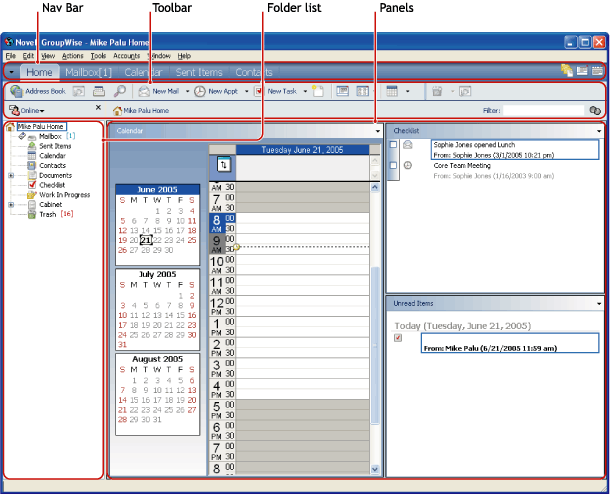1.3 Collaboration Groupware and Messaging
Novell GroupWise is an enterprise collaboration system that provides secure e-mail, calendaring, scheduling, and instant messaging. GroupWise also includes task management, contact management, document management, and other productivity tools. GroupWise can be used on your desktop on Linux, Windows*, or Macintosh*; in a Web browser anywhere you have an Internet connection; and even on mobile devices.
1.3.1 Understanding GroupWise Item Types
Starting the GroupWise Client
The GroupWise should be installed on your desktop. To launch the client, click the GroupWise icon.
Getting Acquainted with the GroupWise Main Window
Your main work area in GroupWise is called the Main Window, where you can read your messages, schedule appointments, view your calendar, manage contacts, and more.
-
Nav Bar: Provides access to all commands and options that can be performed in GroupWise.
-
Toolbar: Provides quick access to common tasks such as composing a new mail message.
-
Folder List: Shows the different objects and folders for your GroupWise account. Items listed here would include your cabinet of saved e-mails, trash, a sent items folder, and your calendar.
-
Panels: Shows you the contents of the item that you have selected. The default is e-mail messages.
Figure 1-1 GroupWise Work Area

1.3.2 GroupWise Icon Types
The icons that appear next to items in your mailbox, sent items folder, and the calendar show information about the items. The following table explains what each icon means.
Table 1-1 Icon Descriptions
1.3.3 Sending Mail
A mail message has primary recipient, subject line, date, and can be carbon copied and blind copied to other users. You can also attach files, document references, sounds, movies and other objects to your mail messages.
-
Click on the toolbar.
-
In the field, type a user name, then press . Repeat for additional users. If necessary, specify usernames in the and fields.
or
To select usernames from a list, click on the toolbar, double-click each user, then click .
-
Type a subject for your message.
-
Type the text of your message
-
To include attachments, click the paper clip icon on the toolbar.
-
When you have completed your message and entered your addressees, click on the toolbar.
1.3.4 GroupWise Messenger
Novell GroupWise Messenger is a corporate instant messaging product that uses eDirectory for its user database.
You can create a Contact List, send instant messages, create an archive of messages, allow and block others from seeing your availability, and more.
-
Menu Bar: Used to send e-mails and to configure your Messenger.
-
Status Bar: Shows logged-in users and their status on Messenger.
-
Contact List: The listing of people in your list of contacts. It also shows a status of sent and received messages from each contact.
-
Action Menu: Enables you to send messages, add contacts, etc.




































